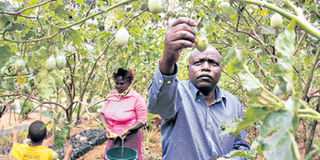I have found fame and fortune in tamarillo

John Kosgei, his wife and children at their farm in Kapsabet. PHOTO | JARED NYATAYA
What you need to know:
- In 2011, armed with the knowledge he had received from the workshop, he destroyed the 11 plants and planted 110 seedlings spacing them at the conventional two by two metres space.
- He advises farmers to diversify their crops to meet the dynamic consumer preferences. However, he counsel that one should seek advice before investing in such enterprises.
On the outskirts of Kapsabet town, John Kosgei is sending tongues wagging.
Kosgei is growing a crop many have never seen before, the reason residents of Chebarbar village would not stop talking about him.
He is farming Tamarillo, a crop that resembles tomatoes and is also known as Tree Tomato.
“I started growing Tamarillo out of curiosity. I credit it to my wife because had she not bought the fruits in the supermarket and came with them home in 2010, I would not have ended up farming them,” says Kosgei, whose wife is a head teacher.
Out of curiosity, Kosgei dried the Tamarillo seeds, which he extracted from the juicy fruit.
He then planted the seeds in a nursery that he had been using to grow other crops. “I was excited when the over 20 seeds germinated. I transplanted them but only 11 trees survived. They did not do well thereafter.”
Kosgei attended a workshop on horticultural farming in Kapsabet town later where he took keen interest in cultivation of the crop.
He figured out where he had gone wrong. “I discovered that I had spaced them incorrectly besides failing to take care of them properly.”
In 2011, armed with the knowledge he had received from the workshop, he destroyed the 11 plants and planted 110 seedlings spacing them at the conventional two by two metres space.
He mulched them during the dry season and pruned them correctly.
“Transplanting is done when the seedlings are between 60 to 70 days old or when the seedling is 15 to 20cm long. Planting holes should be dug 30 to 45cm deep with a diameter of 60cm to accommodate sufficient volume of manure,” explains Kosgei.
When his crops started to flower in September 2012, they attracted several residents who came to his farm to inquire about them.
“It is a lucrative venture and since I am the only farmer in this region, the market is overwhelming. Customers even book them before they ripe. They come from as far as Eldoret,” says the farmer, who notes one of his biggest challenges is lack of enough water.
According to Kosgei, growing Tree Tomato is not labour intensive and requires little capital to start.
“The crops take about a year to mature. One then picks fruits twice a week for the whole year except when you spray them to kill pests.”
Each tree produces an average of 125kg of fruits annually. He, therefore, picks approximately 13.5 tonnes of fruits yearly and sells a kilo locally at Sh30.
“I get buyers from surrounding areas and beyond. Some come here, others I supply to them.”
He says his production is steady except when the weather is cold.
In Kapsabet, July is chilly while March is the driest month. “Compared to maize, which other farmers grow, the proceeds from Tree Tomato are better. Here, maize farmers get on 0.2 acre like mine Sh15,000,” says Kosgei, who is a Horticultural Corporation Development Authority licensed operator.
Other crops he grows include grafted avocados, bananas and passion fruits.
He also grows flowers like daisies, roses, lilies, dew and landers.
However, the most outstanding crops on his farm are the over 5,000 Tamarillo seedlings, which he sells at Sh50 each.
“Nursery operators are normally adventurous. We try out different plants especially unique ones. Many people thought the crop could not grow because not a single farmer had ever attempted planting it before in this area,” says Kosgei, 48, who has used proceeds from the farming venture to pay for his children’s school fees and his education at Gretsa University, Kapsabet, where he is undertaking Bachelor of Arts in Developmental Studies.
Amos Ego, a plant breeder at University of Eldoret, says Tamarillo is a delicious egg-shaped fruit, whose origin is South America.
“The plant looks strange because its skin is not eaten. The skin is tough and bitter but the flesh is sweet and juicy. The flesh holds soft black seeds nested in a red gel, which is sweet,” he says.
The fruit has an upright trunk with lateral branches that bear pink-white fragrant flowers, shallow roots and yields long fruits with dark longitudinal stripes.
“Because of such roots, the crop should be planted in deep holes to protect them from winds. They also require moderate well-distributed rainfall, temperature of between 15 to 20 degrees Celcius and a soil pH of five to 8.5.”
Ego, however, says the crop is highly susceptible to bacterial wilt and should not be intercropped with crops such as potatoes and cabbages.
He adds, “Organic manure used should be fully decomposed to ensure that it does not become a source of diseases and to ensure that maximum nutrients are obtained especially when farm yard manure is used.” In addition, the crop should be sheltered from direct winds to protect flowers and fruits from damage.
He advises farmers to diversify their crops to meet the dynamic consumer preferences. However, he counsel that one should seek advice before investing in such enterprises.
“Farmers in areas such as Nandi County where the crop is new should be cautious not to introduce diseases especially through contaminated seeds and seedlings,” he says, and adds that they can seek information from others who grow the crop in Ainabkoi, Uasin Gishu County.




